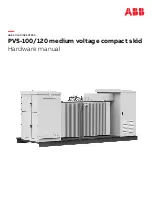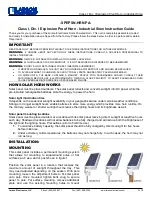
Page 52
©
2017 Sensata Technologies
Appendix B – Battery Information
Appendix B – Battery Information
B-1 Battery
Location
Periodic maintenance (i.e., checking connections, cleaning, watering) on batteries is required.
Locate the batteries in an accessible location to perform this maintenance. Two feet clearance
above the batteries is recommended for access to the battery terminals and removable caps (lead
acid battery types). The battery bank should be located as close to the inverter as possible without
limiting access to the inverter’s disconnects.
B-2 Battery
Types
Batteries are available in different sizes, amp-hour ratings, voltage and chemistries. They are also
available for starting applications (such as an automobile starting battery) and deep discharge
applications. Only the deep cycle types are recommended for inverter applications; using a starting
battery in an inverter (deep cycle) application will greatly shorten their useful life. Choose the
batteries best suited for the inverter installation and cost. Use only the same battery type for all
batteries in the bank. For best performance, all batteries should be from the same lot and date.
This information is usually printed on a label located on the battery.
B-3 Battery
Temperature
Battery performance of lead-acid type batteries is greatly affected by extreme temperatures. When
a lead-acid type battery is cold, its effective amp-hour capacity is reduced. When determining
the battery requirements needed for the inverter system, realize that the battery capacity will be
reduced if they will be installed in a climate where extremely cold temperatures are expected. In
this type of environment, the batteries should be located in a heated area. At the minimum, the
batteries should be installed in an insulated enclosure; which will keep the batteries warmer as
they are being charged.
The battery bank should also be protected from high temperatures, which will shorten battery
life. In high heat situations the battery room/enclosure should be ventilated to bring in cooler air
and exhaust the hotter air. The performance of the battery bank/inverter system will substantially
increase by monitoring and preventing extreme temperatures around the batteries.
B-4
Battery Bank Sizing
The size of the battery bank determines how long the inverter will power the AC loads without
recharging. The larger the battery bank, the longer the run time. Size your battery bank to the
systems AC load requirements and length of time required to run from the batteries. In general,
the battery bank should not be discharged more than 50%. Additional DC charging devices such
as solar, wind, hydro, etc. can provide longer run times by recharging the batteries in the absence
of AC utility or generator power. See also Appendix C, Section C–1.
Info:
For the MS-PAE Series inverter/charger to perform optimally, a minimum battery
bank of 200 AH is recommended for moderate loads (<1000W) and greater than 400
AH for heavy loads (
≥
1000W).










































